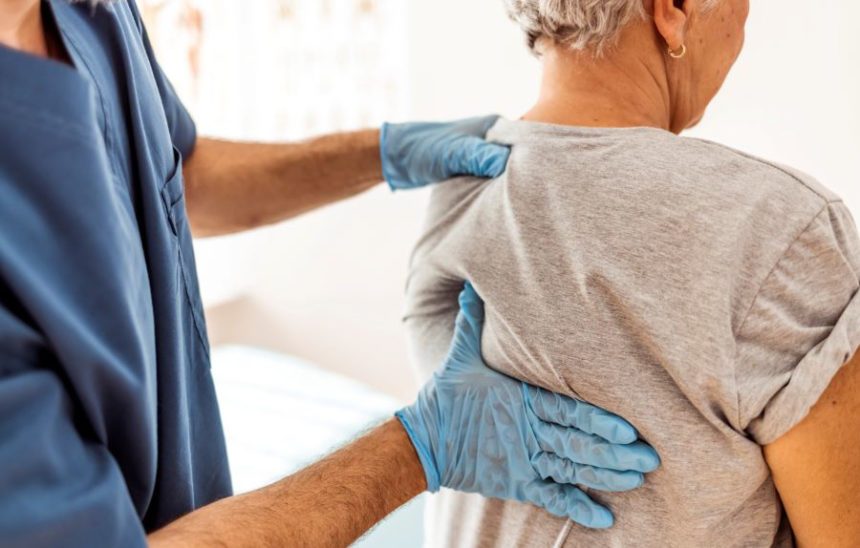The spine is your body’s central support structure. It allows you to stand, sit and move.
But as you age, your spine can become more prone to injury because it weakens and wears down over time. This often leads to neck and back pain.
“These problems are caused by mechanical stress such as bad posture over a long period of time and the ongoing aging process, which leads to deterioration of the spine,” says UNC Health neurosurgeon John Engler, MD.
Two of the most common conditions related to aging are degenerative spinal stenosis and herniated disks.
Degenerative Spinal Stenosis
The spine responds to stress over time by thickening the ligaments that support the spine. The joints then start to enlarge, which narrows the spinal canal where the nerves reside.
“You start to get pressure on the nerves. The pressure on the nerves is what causes the symptoms that give you leg pain and arm pain,” Dr. Engler says.
This is called degenerative spinal stenosis, and there are three types: lumbar, cervical and thoracic.
Lumbar stenosis occurs in the lower back and is caused by pressure building up on the spine from the degeneration of the cartilage between the spinal disks.
“This can cause leg pain when walking or numbness in the legs,” Dr. Engler says.
Cervical stenosis is a similar process, but it happens in the neck.
“When it occurs in the neck, the nerve pressure can cause you to feel numb in your hands,” Dr. Engler says. “You may have trouble using your phone or typing on a keyboard.”
Thoracic stenosis is rare because it occurs in the middle back, which is not in motion as much as the lower back and neck, making it less susceptible to degeneration.
Herniated Disk
Spine problems also can be caused by disk herniation, which can cause a shooting pain down your arms or legs. While more common in older people because of wear and tear on the spine, disk herniation can happen at any age because of sudden motions that cause injury.
“In young people it can occur from CrossFit or they were playing soccer, and they had a sudden popping sound and pain down their arms and their legs,” Dr. Engler says. “In an older population, the disk space is starting to wear out, and you’ve got accumulated wear and tear on the disk space. A piece herniates out and hits on the nerve, and then you get pain.”
Disk herniation and degenerative spinal stenosis can occur together.
Nonsurgical Treatment Options for Spine Pain
The first option for treatment for almost any spine-related injury or pain is physical therapy. A physical therapist will teach you specific exercises to strengthen your back, abs and hips, as well as stretches that can help with mobility. By increasing strength, endurance and flexibility, you often can reduce pain and improve function.
“Physical therapy is designed to strengthen the supporting structures of the spine to offset the pressure on the nerves,” Dr. Engler says. “If the muscles have become stronger, then it can offset our body’s weight and give the nerves a little bit more space, and oftentimes people will improve.”
If physical therapy does not help or is not an option because the pain has caused significant weakness or an inability to perform physical therapy, the next options are anti-inflammatory medications or targeted injections for the pain management.
“With the medication, we’re trying to control the symptoms so you can participate in physical therapy,” Dr. Engler says.
The injections are typically epidural steroid injections (ESIs). Pain management specialists inject a local anesthetic and a steroid medication directly into the epidural space that surrounds the spinal cord and nerve root. The injection is designed to reduce inflammation around the nerves causing the pain.
Surgical Treatment for Spine Problems
If none of these treatments work, surgery may be necessary. And there is some research that shows for lumbar stenosis, surgery is the most effective treatment option, Dr. Engler says.
The goal of surgery is to remove the process that is putting pressure on the nerves or spinal cord. This is done by removing the bone, ligament or disk that is putting pressure on the nerves or spinal cord. The approach is tailored to the patient’s unique needs.
“Pressure on these nerves is what is causing your symptoms. We’re going to go relieve the pressure on the nerves. If you relieve the pressure on the nerves, the nerves can start to heal,” Dr. Engler says. “We’re trying to reestablish a normal environment for the nerves to function properly. Spine surgery is about improving quality of life and physical function.”
If you are experiencing spine pain, talk with your doctor. If you need a doctor, find one near you.

